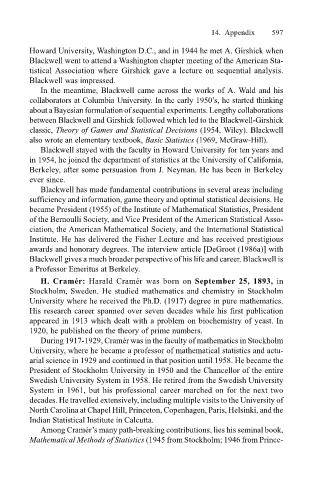Page 620 - Probability and Statistical Inference
P. 620
14. Appendix 597
Howard University, Washington D.C., and in 1944 he met A. Girshick when
Blackwell went to attend a Washington chapter meeting of the American Sta-
tistical Association where Girshick gave a lecture on sequential analysis.
Blackwell was impressed.
In the meantime, Blackwell came across the works of A. Wald and his
collaborators at Columbia University. In the early 1950s, he started thinking
about a Bayesian formulation of sequential experiments. Lengthy collaborations
between Blackwell and Girshick followed which led to the Blackwell-Girshick
classic, Theory of Games and Statistical Decisions (1954, Wiley). Blackwell
also wrote an elementary textbook, Basic Statistics (1969, McGraw-Hill).
Blackwell stayed with the faculty in Howard University for ten years and
in 1954, he joined the department of statistics at the University of California,
Berkeley, after some persuasion from J. Neyman. He has been in Berkeley
ever since.
Blackwell has made fundamental contributions in several areas including
sufficiency and information, game theory and optimal statistical decisions. He
became President (1955) of the Institute of Mathematical Statistics, President
of the Bernoulli Society, and Vice President of the American Statistical Asso-
ciation, the American Mathematical Society, and the International Statistical
Institute. He has delivered the Fisher Lecture and has received prestigious
awards and honorary degrees. The interview article [DeGroot (1986a)] with
Blackwell gives a much broader perspective of his life and career. Blackwell is
a Professor Emeritus at Berkeley.
H. Cramér: Harald Cramér was born on September 25, 1893, in
Stockholm, Sweden. He studied mathematics and chemistry in Stockholm
University where he received the Ph.D. (1917) degree in pure mathematics.
His research career spanned over seven decades while his first publication
appeared in 1913 which dealt with a problem on biochemistry of yeast. In
1920, he published on the theory of prime numbers.
During 1917-1929, Cramér was in the faculty of mathematics in Stockholm
University, where he became a professor of mathematical statistics and actu-
arial science in 1929 and continued in that position until 1958. He became the
President of Stockholm University in 1950 and the Chancellor of the entire
Swedish University System in 1958. He retired from the Swedish University
System in 1961, but his professional career marched on for the next two
decades. He travelled extensively, including multiple visits to the University of
North Carolina at Chapel Hill, Princeton, Copenhagen, Paris, Helsinki, and the
Indian Statistical Institute in Calcutta.
Among Cramérs many path-breaking contributions, lies his seminal book,
Mathematical Methods of Statistics (1945 from Stockholm; 1946 from Prince-

